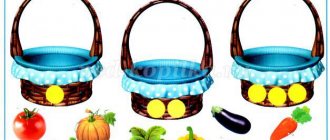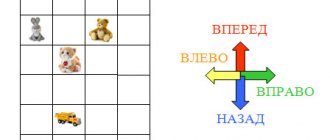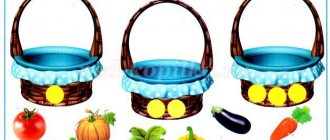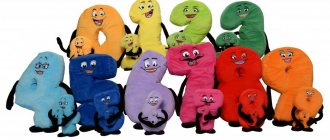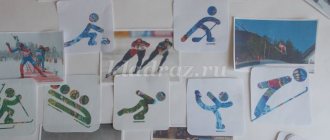Didactic games for preschoolers. Fun facts about mathematics (middle group) on the topic
Didactic games on FEMP
"Mosaic", "Puzzles"
Purpose: develops hand motor skills, attention, logical thinking, perseverance.
"Colors and Shapes"
Goal: helps the child learn basic colors and their shades, basic shapes, as well as such important concepts as “big”, “small”, “more”, “less”.
Lotto "Fun Math"
Goal: develops attention, logical thinking, perseverance, continues to teach counting up to 100, trains visual memory.
Smart domino "subtraction"
Goal: develops hand motor skills, attention, logical thinking, perseverance, trains visual memory, strengthens subtraction skills.
"Children about time"
Purpose: the game introduces children to time concepts (seasons, months, days of the week, parts of the day, hours), develops storytelling skills using pictures.
“Choose by color and shape”
Goal: development of logical and figurative thinking, voluntary and involuntary attention.
"Opposites"
Goal: development of attention, speech, figurative and semantic memory, lays the foundations of logical thinking.
"Fun Logic"
Goal: develops imaginative thinking, analytical perception, develops the ability to visually examine and analyze objects, their verbal description and mental construction.
"Seasons"
Goal: develops memory, observation, creates interest in the world around us.
"Color Geometry"
Goal: consolidates knowledge about geometric shapes and colors, develops attention, perception, and logical thinking.
"Kaleidoscope of figures, colors, activities"
Goal: develops spatial orientation, artistic and creative imagination, intelligence and attention, in a playful way teaches mastery of geometric shapes, the ability to identify one specific color from a variety of colors.
"Solving Examples"
Goal: strengthening counting skills, mastering mathematical operations: addition and subtraction, teaches how to compose and solve problems.
Didactic games for speech development
"My apartment"
Goal: to form children’s knowledge about the characteristic furnishings of the apartment; the game teaches them to choose the right picture with the furnishings for the selected part of the apartment, to develop thinking, intelligence, the ability to explain their actions, and memory.
Lotto “All professions are important”
Goal: develops speech, thinking, speech apparatus, ideas about professions.
“Call it in one word”
Purpose: develops logical thinking, dexterity and speed of thought and action of the player.
"Speech therapy lotto"
Goal: develops phonemic hearing, teaches how to pronounce sounds correctly, studies sound-letter analysis of words, develops attention, memory, and thinking.
"On the Path of Words"
Goal: develops coherent speech, attention, memory, imagination, logical thinking and phonemic hearing in children.
"We will build a house"
Purpose: develops memory, thinking, imagination, to form children’s knowledge about characteristic objects of building material, the game teaches them to choose the right picture.
"The Fourth Wheel"
Goal: develops logical and figurative thinking, speech apparatus.
"Chain of Words"
Goal: develops the ability to detect the location of the first and last sounds in words.
"Let's play"
Purpose: the game develops sensory education, visual perception, forms the development of stable ideas about the shape, color, size of objects, teaches how to establish coincidence and discrepancy.
“I know all professions”
Purpose: introduces professions, trains memory, attention, logical thinking and speech.
"We're playing shop"
Goal: introduces children to items sold in stores, children’s ability to classify items, name groups of items with generalizing words.
Didactic games about the world around us
“Animals and birds: what they say and what they eat”
Goal: develops speech, introduces animals and birds, as well as how they “speak” and what they eat.
"Pets" I
Goal: introduces children to the benefits of pets, their varieties, how they are useful in the household, develops voluntary and involuntary attention, memory, imaginative and logical thinking.
"Hares in the Forest"
Goal: introduces predatory and herbivorous animals, develops logical thinking, memory, and speech.
"Chekhagor"
Purpose: develops attention, logical thinking, dexterity and speed of thought and action of the player.
"Animals and their young"
Goal: introduces animals to central Russia, expands vocabulary, develops memory, teaches correct speech, forms the foundations of logical thinking (generalization, division into groups).
"Nectarine"
Purpose: the game develops attention, logical thinking, dexterity and speed of thought and action of the player.
"Slices"
Goal: development of visual perception, voluntary attention, introduces fruits, vegetables and berries, memory.
"Pets" II
Goal: introduces children to the world around them and enriches them with knowledge about animals, their cubs, as well as the barnyard, teaches the child to generalize, analyze and compare.
"Catch a Fish"
Purpose: introduces children to aquatic inhabitants, develops visual perception, voluntary attention, memory and logical thinking.
Lotto “Twins” (birds)
Goal: introduces children to the varieties of birds, their habitat, develops voluntary and involuntary attention, memory, and speech apparatus.
Lotto “Twins” (insects and reptiles)
Goal: introduces children to the varieties of insects and reptiles, their habitat, develops voluntary and involuntary attention, memory, and speech apparatus.
"Let's get to know the living world"
Purpose: introduces domestic and forest animals, forest and agricultural plants, forest and garden flowers, forest and garden berries, vegetables and fruits.
"Pick a picture"
develops attention, memory, thinking, teaches to classify objects, name groups of objects with generalized words, enriches vocabulary.
Didactic game - puzzles for children of senior preschool age. "Family holidays".
Municipal budgetary preschool institution kindergarten "Teremok".
Didactic game - puzzles for children of senior preschool age.
«Family holidays".
Educator:
first qualified category
Maryina S.I.
Gubakha urban district "city of Gubakha", 2020
Didactic game
"
Family holidays".
Tasks:
For the teacher:
didactic:
— clarify the level of children’s knowledge about their families, family holidays, traditions (hobbies);
- expand initial ideas about family holidays and traditions.
educational:
- cultivate feelings of family cohesion (based on ideas about the family, its composition, friendly relationships and home comfort);
developing:
- develop visual - figurative, logical thinking, memory, the ability to compose a whole from parts.
•Cultivating feelings of love and pride for your family, respect for parents,
family traditions. Development of communication skills, kindness and
mutual understanding in students' families
Tasks:
1) cognitive aspect: using the game to expand the understanding of various
families, spending free time at home and outdoors;
2) developmental aspect: developing group work skills; capabilities
prove your opinion;
3) educational aspect: introduce the classification of holidays, consolidate
students' knowledge of family traditions;
4) educational aspect: nurturing feelings of love, pride in one’s family,
respect for parents and relatives; developing an interest in your family history,
family tradition
Game task for children:
assemble a picture from separate parts.
Rules:
organizational:
— from 2 to 6 players, 1 presenter; place at the table;
disciplinary:
- observe the rules of behavior during the game (be able to choose a leader, not interfere with each other, be attentive).
gaming:
- whoever is the first to assemble a whole from individual parts wins.
Game actions:
The presenter invites the children to select and examine pictures depicting various holidays as a sample. Then the presenter places small cut-out pictures of a particular holiday in the center of the table. At the presenter’s signal, players select small cut-out pictures, combining them into one whole, depending on their affiliation with the holiday. The winner is the one who quickly assembles the picture from the individual parts. At the end of the game, the children compare the resulting image with the image of the holiday picture; talk about the tradition of celebrating their family.
Game attributes:
— 6 pictures depicting various holidays; 72 small cut cards depicting a specific holiday. Cut cards of a certain holiday are interconnected by the principle of dividing into 12 parts, cut: vertically, horizontally, diagonally, into large and small squares, rectangles, triangles, etc.
Math puzzles
The game is intended for preschoolers of the preparatory group; it develops basic mathematical knowledge, teaches them to count to 10, and develops memory, attention and visual perception.
To play, you need pictures that need to be divided into 10 longitudinal strips of equal width. On the left end of each strip you need to write a specific number from 1 to 10. The numbers must go in order from the top to the bottom edge of the picture, which then needs to be cut into strips.
The teacher lays out the strips in front of the child and asks them to make a picture, focusing not only on the matching parts of the image, but also on the numbers.
Perform developmental exercises from Ikyusha
Mathematics
Reading
The world
Logics
English language
Putting together puzzles for 4 years old
At five years old, children can be given a more difficult task - to collect not just a picture, but a work of art. This is where you can start getting acquainted with paintings by different authors. In the exercise “Reproductions of paintings” we made puzzles based on the works of famous painters. Such puzzles are suitable for older children and even adults:
Puzzles “Reproductions of paintings”
Six golden rules
After the improved Tic-Tac-Toe, Alena began to come up with the following games, and in the process she identified seven important rules for herself that will become the key to an interesting and useful game:
- The game is for kids, not adults. To keep children interested, don't make the game too hard or too easy.
- For children it is entertainment, for the teacher it is a tool. The game is not just for fun. And if this is entertainment for children, then the teacher must formulate the goal that he wants to achieve with this activity, for example, to consolidate educational material or develop the logical thinking of children.
- "Squares" is a universal playing field. For an introduction to floor games, the universal playing field “Squares” is perfect: a rectangle made up of 24 squares. The recommended size is 1.4 by 2.8 meters to make it easier for children to move around. You can create the playing field yourself, for example, draw squares with electrical tape on the floor, or you can use ready-made material, for example, banner cloth.
- Game is movement. Think about what the child should do: remove pictures, spin a hoop, jump with a ball. Children love movement, and standing still will be boring for them.
- Rules are the basis of order. Think and clearly explain to children what can be done during the game and what cannot be done. This will make it easier to control the process and achieve didactic goals.
- Everything is good in moderation. To prevent children from getting bored with games, it is optimal to conduct them no more than two or three times a week. The exception is play activity during morning exercises: it is part of an exercise cycle and takes only a few minutes.
Alena came up with a whole series of outdoor games, which were included in her collection “Outdoor Games and Activities for Children,” and shared with us five activities that can easily be done with kids.
Puzzles for children 4-5 years old
Slightly older children can already quite easily solve puzzles with a small number of parts. Offer them colorful pictures or photo puzzles:
Puzzles for preschoolers
Preschool children can be offered both puzzles with bright pictures and photo puzzles on the topic of children's activities.
Putting together puzzles for 6 year olds
Puzzles for little ones (2-3 years old)
Special puzzles for kids are bright and simple pictures consisting of a small number of parts. Children do not need to overload their visual attention with a large number of elements. To start developing the skill of solving puzzles, 4 pieces are enough.
Putting together puzzles for 2 years old
After successful training on small pictures, you can move on to nine-part images:
Putting together puzzles for 3 years old

